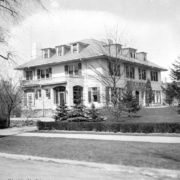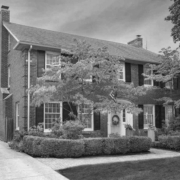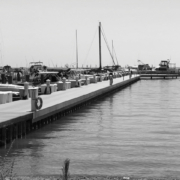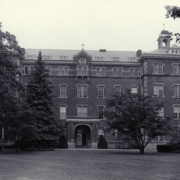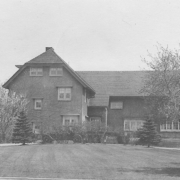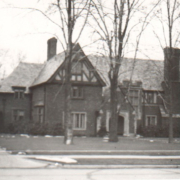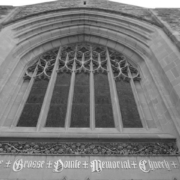Historical Architecture of Grosse Pointe – 17805 E Jefferson
Last week we turned our attention to a very special home – 29 Fisher. It is reported 29 Fisher was formerly the stables on the estate that was once owned by Matilda Dodge – 17805 E. Jefferson. Mrs. Dodge purchased the estate from W. Howie Muir in 1921. It is rumored the stables, on the original Muir estate, had been converted from an existing building (around 1925) by Smith, Hinchman & Grylls for Mrs. Dodge who was an avid rider.
This week we would like to present the full story of 17805 E Jefferson, the huge W. Howie Muir estate completed in 1913, by the renowned designers Chittenden and Kotting. The W. Howie Muir residence was a grand 35-room Colonial home located on a large lot that ran from Lincoln to Fisher Road. The exterior of 17805 Jefferson was white stucco. A hip roof (where all four sides of the roof slope down toward the walls), with multiple dormer windows dominated the design. The south elevation overlooked the expansive lawn and had a perfect view of the lake – the main entrance was located on the side of the property. Sadly we can’t locate any photos of the interior – if you have any information we would love to hear from you. Image courtesy of: Walter P. Reuther Library, Archives of Labor and Urban Affairs, Wayne State University.
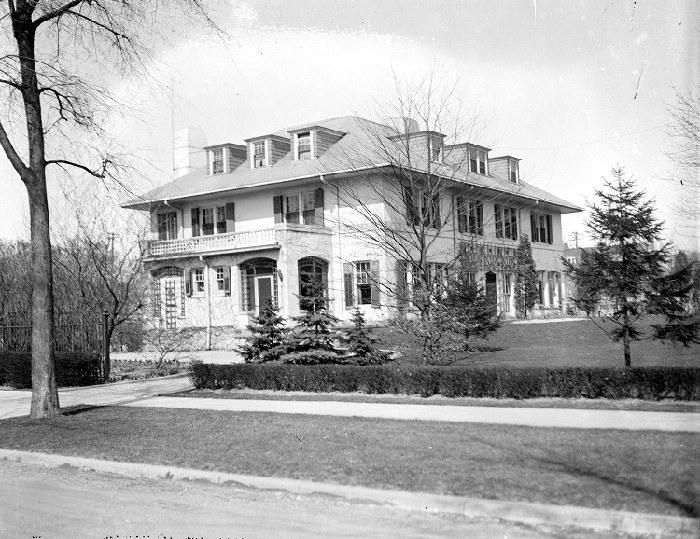
The original owner, W. Howie Muir, was recognized as one of Detroit’s captains of industry. He was born in Detroit in 1867. His father, William Ker, a railroad mechanical engineer, was born in Kilmarnock, Scotland. In October 1852, William Ker was offered a job with the Great Western Railway of Canada and relocated to North America with his family. In 1857, having resided in Canada for five years, William Ker moved his family to Detroit to take the position of general manager of the Detroit Grand Haven & Milwaukee Railroad. His only son, W. Howie, was educated in the Michigan Military Academy. In 1888, W. Howie graduated from the University of Michigan with a degree in mechanical engineering. Four years later, in 1892, W. Howie became one of the organizers of the Jenks & Muir Manufacturing Company, which manufactured brass and iron bedsteads – serving as vice president and treasurer. By 1922, Jenks & Muir was one of Detroit’s largest manufacturers. It has been reported the manufacture of iron and brass bedsteads became one of Detroit’s largest manufacturing interests outside of the auto industry. During his career W. Howie Muir was also involved in street railway construction. He was married to Marion Lewis and they had three children. W. Howie Muir passed in 1929. Source: The City of Detroit, Michigan, 1701-1922, vol. 4. Image courtesy of Archive.org – The American Architect, Volume 111.
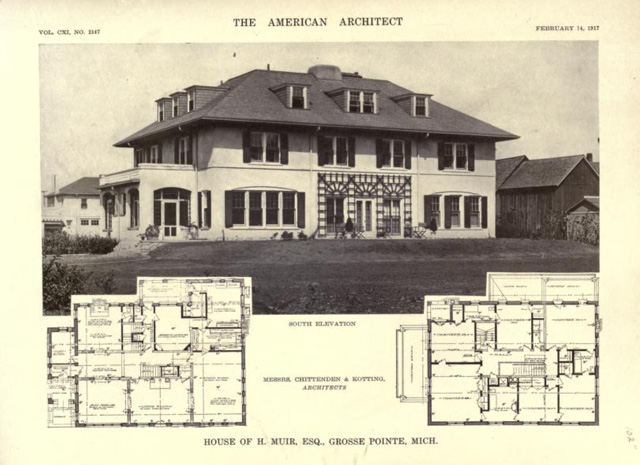
Howie’s Muir’s, father, William Ker was also a familiar figure in Grosse Pointe. In 1882, having spent several summers in Grosse Pointe, William Ker purchased the property that he had rented for multiple summer seasons and rebuilt it to become a permanent home for himself and his family – including his son W. Howie. The Muir’s were one of the earliest families to make Grosse Pointe their permanent year-round home. The property Mr. Muir purchased was known as Otsikata Villa (‘Otsikita’ was once the Indian name for Lake Sainte Claire). Image courtesy: the Grosse Pointe Historical Society.
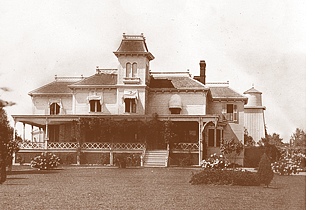
In 1921, W. Howie’s time at 17805 E Jefferson came to an end. He had commissioned Marcus Burrowes & Frank Eurich to design a new home for his family – 522 Rivard (completed in 1921-22), while his former home was purchased Matilda Dodge, the widow of John Francis Dodge. After her husband’s untimely death (January 1920) Matilda inherited his share of the Dodge Brothers Company and became one of the wealthiest women in the United States.
At this point it is believed the former Muir estate not only had a new owner, but also a new address – 244 Lincoln. It is understood Matilda Dodge made several major changes to the estate to make it more suitable for herself and her three children. This included commissioned the renowned firm of Smith, Hynchamn and Grylls to convert an existing building into a stable (around 1925). It is also reported there was a playhouse located on the estate.
Post 1930, the stable building on the former Muir/Dodge estate had been purchased by Mr. Marion Knight Kellogg. Work began to convert the building from a stable into a “French country home” – a private residence for Mr. Kellogg and his wife Virginia Dryden. The former stable is now 29 Fisher.
Meanwhile, the story of the former Muir estate continued. During its history the property had been owned by several prominent figures – William H. Muir, Matilda Dodge, a member of the Alger family, followed by Capt. William J. Scripps (publisher of the Detroit News). Post 1945, the property was purchased by Mr. John H. Zimmers, part owner of Herron-Zimmers Moulding Company. We understand prior to moving to 17805 E Jefferson Mr. Zimmers lived at 774 Westchester with his wife Mary and their four daughters. By 1953, it is apparent the Zimmers were now residing at 121 Lothrop, however, they still owned the former Muir estate. During the four years the Zimmers had owned 17805 E Jefferson is reported the couple had invested approximately $18,000 (around $220,000 today) in improving and decorating the interior and exterior of the house. Source: Grosse Pointe News, February 1954.
The same article in the Grosse Pointe News also reported that in December 1953, 17805 E Jefferson had suffered catastrophic damage when a pipe burst on the third floor. It is reported ’tons of plaster had peeled off the ceilings and walls and mahogany panels, doors and the wooden framework of the building were swelled to many times their size by the gushing water’. The property, at the time, had been vacant for about a year and a half and so the burst pipe wasn’t discovered straight away. ‘The gushing water had run for days before it was discovered and turned off’. The article also states that the estimated damage to the house was $39,000 (around $400,000 today). The article also explains that ‘when the house was originally built parts of the ceiling was at least a foot thick, and that the plaster on the walls measured a good three inches’. By the time the flood was discovered, ‘the damage in the dining room alone had resulted in ‘seven tons of plaster to peel from the ceiling.’ The Zimmers subsequently listed the house for sale, as it was. Whoever purchased the property, it is reported, had the choice to either repair the damage or sub divide the property. Source: Grosse Pointe News, February 1954. 17805 E Jefferson was sold, demolished soon after, and the land was subdivided – another lost Chittenden and Kotting home (you can read the full story here).
17805 E Jefferson was a landmark property, one of the finest homes constructed on Jefferson prior to World War I. While the estate has gone the Muir name lives on in the form of Muir Road (formerly called Oak Road) that stands as a reminder to a family who became one of the earliest permanent residents in Grosse Pointe.
*Photos courtesy of the Higbie Maxon Agney archives unless stated.
Written by Katie Doelle
Copyright © 2021 Katie Doelle

